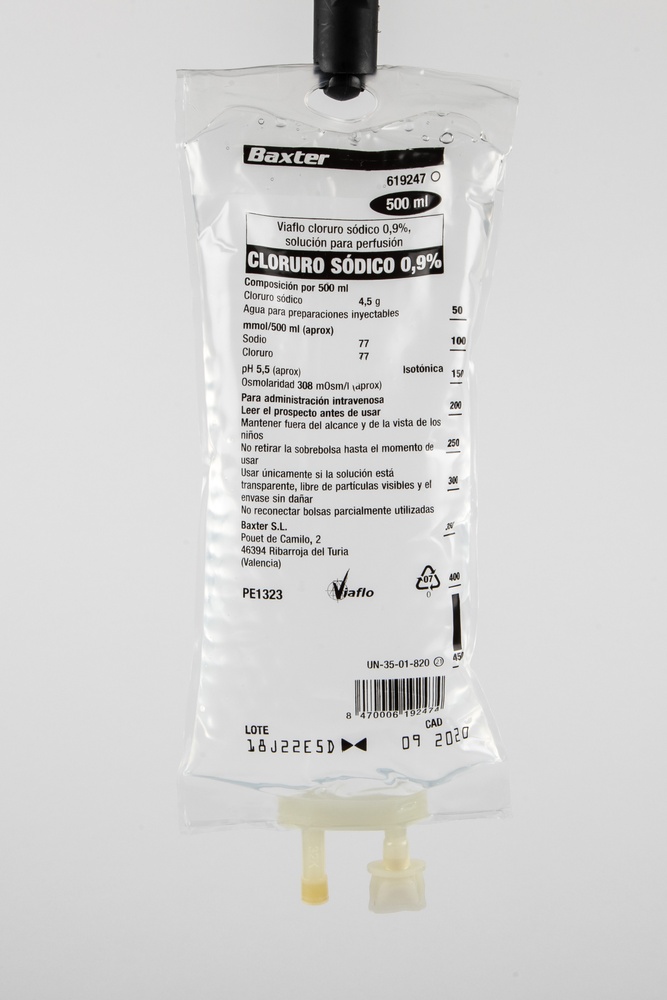

VIAFLO CLORETO DE SÓDIO 0,9% E CLORETO DE POTÁSSIO 0,3% SOLUÇÃO PARA PERFUSÃO

Pergunte a um médico sobre a prescrição de VIAFLO CLORETO DE SÓDIO 0,9% E CLORETO DE POTÁSSIO 0,3% SOLUÇÃO PARA PERFUSÃO

Como usar VIAFLO CLORETO DE SÓDIO 0,9% E CLORETO DE POTÁSSIO 0,3% SOLUÇÃO PARA PERFUSÃO
Introdução
PROSPECTO: INFORMAÇÃO PARA O UTILIZADOR
Viaflo Cloruro de sódio 0,9% e Cloruro de potássio 0,3% solução para perfusão
Princípio ativo: cloruro de sódio e cloruro de potássio
Leia todo o prospecto detenidamente antes de começar a usar este medicamento porque contém informações importantes para si.
- Conserva este prospecto, pois pode ter que voltar a lê-lo.
- Se tiver alguma dúvida, consulte o seu médico ou enfermeiro.
- Se experimentar efeitos adversos, informe o seu médico ou enfermeiro, mesmo que se trate de efeitos adversos que não aparecem neste prospecto. Ver secção 4.
Este medicamento denomina-se “Viaflo Cloruro de sódio 0,9% e Cloruro de potássio 0,3% solução para perfusão”, mas será referido como “Viaflo Cloruro de sódio 0,9% e Cloruro de potássio 0,3%” no resto deste prospecto.
Conteúdo do prospecto:
- O que é Viaflo Cloruro de sódio 0,9% e Cloruro de potássio 0,3% e para que é utilizado
- O que necessita saber antes de que lhe administrem Viaflo Cloruro de sódio 0,9% e cloruro de potássio 0,3%
- Como lhe administrarão Viaflo Cloruro Sódio 0,9% e Cloruro de potássio 0,3%
- Posíveis efeitos adversos
- Conservação de Viaflo Cloruro Sódio 0,9% e Cloruro de potássio 0,3%
Conteúdo do envase e informação adicional
1. O que é Viaflo Cloruro de sódio 0,9% e cloruro de potássio 0,3% e para que é utilizado
Viaflo Cloruro de sódio 0,9% e cloruro de potássio 0,3% é uma solução de cloruro de sódio e cloruro de potássio em água. O cloruro de sódio e o cloruro de potássio são substâncias químicas (comumente chamadas sais) que se encontram no sangue.
Viaflo Cloruro de sódio 0,9% e cloruro de potássio 0,3% é utilizado para tratar e prevenir:
- uma perda de potássio do corpo (perda de potássio, por exemplo, após o tratamento com certos diuréticos [comprimidos para urinar])
- um nível baixo de potássio no sangue (hipopotasemia)
Em situações que podem causar a perda de água e de cloruro de sódio, incluindo:
- quando não pode comer ou beber, devido a uma doença ou a uma intervenção cirúrgica
- sudorese excessiva causada por febre alta
- perda de grande superfície de pele, como ocorre em queimaduras graves
2. O que necessita saber antes de que lhe administrem Viaflo Cloruro de sódio 0,9% e cloruro de potássio 0,3%
NÃOdeve ser administrado Viaflo Cloruro de sódio 0,9% e cloruro de potássio 0,3% se sofrer alguma das seguintes situações clínicas:
- se é alérgico ao cloruro de sódio e cloruro de potássio ou a algum dos outros componentes deste medicamento (incluídos na secção 6).
- se o seu sangue contém níveis altos de potássio superiores aos normais (hiperpotasemia)
- se o seu sangue contém níveis altos de cloruros superiores aos normais (hipercloremia)
- se o seu sangue contém níveis altos de sódio superiores aos normais (hipernatremia)
- insuficiência renal grave (quando os seus rins não funcionam bem e requer diálise)
- se apresenta insuficiência cardíaca não compensada. Trata-se de uma insuficiência cardíaca que não recebe o tratamento adequado e que ocasiona sintomas como:
- dificuldade respiratória
- inchaço dos tornozelos.
- Doença de Addison (função da glândula suprarrenal deteriorada. Esta glândula produz hormonas que ajudam a controlar as concentrações das substâncias químicas no corpo).
Advertências e precauções
Viaflo Cloruro de sódio 0,9% e cloruro de potássio 0,3% é uma solução hipertónica (concentrada). O seu médico terá isso em conta ao calcular a quantidade de solução que lhe será administrada.
Informa ao seu médico se tem ou teve alguma das seguintes situações clínicas:
- qualquer tipo de doença do coração ou insuficiência cardíaca
- função renal deteriorada
- insuficiência adrenocortical (doença das glândulas adrenais que afeta as hormonas que controlam a concentração de substâncias químicas no organismo)
- desidratação aguda (uma perda de água do organismo, por exemplo vómitos ou diarreia)
- danos tissulares extensos (como ocorre em queimaduras graves)
- se está a receber glucósidos cardíacos (cardiotónicos) usados para o tratamento de insuficiência cardíaca, como digitálicos ou digoxina. Serão realizados controles regulares do nível de potássio no seu sangue.
- pressão arterial elevada (hipertensão)
- acúmulo de líquidos sob a pele, particularmente sob os tornozelos (edema periférico)
- acúmulo de líquidos no pulmão (edema pulmonar)
- pressão da sangue alta durante a gravidez (pré-eclampsia)
- qualquer outra condição associada à retenção de sódio (quando o organismo retém demasiado sódio), tais como o tratamento com esteroides (ver também Outros medicamentos e Viaflo Cloruro de sódio 0,9% e cloruro de potássio 0,3%)
- se tem uma afecção que poderia causar níveis elevados de vasopressina, uma hormona que regula o líquido do seu corpo. Pode ter demasiada vasopressina no seu corpo porque, por exemplo:
- teve uma doença repentina e grave,
- tem dor,
- foi operado,
- tem infecções, queimaduras ou lesão cerebral
- tem doenças relacionadas com o seu coração, fígado, rins ou sistema nervoso central,
- está a tomar certos medicamentos ver mais adiante (Outros medicamentos e Viaflo Cloruro de sódio 0,9% e cloruro de potássio 0,3%).
Isso pode aumentar o risco de que haja níveis baixos de sódio no sangue e pode causar dor de cabeça, náuseas, convulsões, letargia, coma, inflamação do cérebro e a morte. A inflamação do cérebro aumenta o risco de morte e de dano cerebral. As pessoas com maior risco de inflamação cerebral são:
- crianças
- mulheres (particularmente se está em idade fértil)
- as pessoas que têm problemas com os seus níveis de líquido cerebral, por exemplo, devido a meningite, sangramento no crânio ou uma lesão cerebral.
Quando lhe estiverem a administrar esta solução, o seu médico poderá tomar amostras de sangue e urina para controlar:
- a quantidade de líquido do seu organismo
- os seus sinais vitais
- a quantidade de substâncias químicas como sódio e potássio no seu corpo (os seus eletrólitos plasmáticos)
- a acidez do sangue e da urina (o seu equilíbrio ácido-base)
- o gráfico do seu coração (ECG)
O seu médico terá em conta se está a receber nutrição parenteral (nutrição dada por perfusão por veia). Durante o tratamento prolongado com Viaflo Cloruro de sódio 0,9% e cloruro de potássio 0,3% você pode necessitar que lhe deem nutrição extra.
Outros medicamentos e Viaflo Cloruro de sódio 0,9% e cloruro de potássio 0,3%
Informa ao seu médico ou farmacêutico se está a utilizar ou utilizou recentemente outros medicamentos, mesmo os adquiridos sem receita.
É particularmente importante que informe ao seu médico se está a tomar:
- glucósidos cardíacos (cardiotónicos) como digitálicos ou digoxina, usados para tratar a insuficiência cardíaca
- medicamentos que incrementam a concentração de potássio no sangue, como:
- diuréticos poupadores de potássio (alguns comprimidos que ajudam a eliminar água, ej amilorida, espironolactona, triamtereno)
- inibidores da enzima conversora de angiotensina (IECA) usados para o tratamento da tensão arterial elevada
- receptores antagonistas da angiotensina II (usados para o tratamento da tensão arterial elevada)
- ciclosporinas (usadas para prevenir rejeição de transplantes)
- tacrolimus (usado para prevenir rejeição de transplantes e tratamento de alterações da pele)
- medicamentos que contenham potássio (por exemplo suplementos com potássio ou substitutos de sal com potássio)
- corticosteroides (medicamentos anti-inflamatórios)
- Alguns medicamentos atuam sobre a hormona vasopressina. Estes podem incluir:
- medicação anti-diabética (clorpropamida)
- medicação para o colesterol (clofibrato)
- alguns medicamentos contra o cancro (vincristina, ifosfamida, ciclofosfamida)
- inibidores seletivos da recaptação de serotonina (utilizados para tratar a depressão)
- antipsicóticos
- opiáceos para o alívio da dor grave
- medicamentos para a dor e/ou a inflamação (também conhecidos como AINE)
- medicamentos que imitam ou fortalecem os efeitos da vasopressina, como desmopressina (utilizada para tratar o aumento da sede e da micção), terlipressina (utilizada para tratar o sangramento do esófago) e oxitocina (utilizada para induzir o parto)
- medicamentos antiepilépticos (carbamazepina e oxcarbazepina)
- diuréticos.
- Recomenda-se precaução em pacientes tratados com lítio. A eliminação das substâncias químicas como sódio e lítio, pelos rins, pode ser incrementada durante a administração de Viaflo Cloruro de sódio 0,9% e cloruro de potássio 0,3%.
Uso deViaflo Cloruro de sódio 0,9% e cloruro de potássio 0,3%com os alimentos e bebidas
Pergunte ao seu médico sobre o que pode comer ou beber.
Fertilidade, gravidez e amamentação
Consulte o seu médico ou farmacêutico antes de utilizar qualquer medicamento.
Informa ao seu médico se está grávida ou em período de amamentação.
Viaflo Cloruro de sódio 0,9% e cloruro de potássio 0,3% pode ser utilizado durante a gravidez. A quantidade que lhe será administrada será cuidadosamente controlada pelo seu médico.
Se for adicionado outro medicamento à solução para perfusão durante a gravidez ou a amamentação, você deve:
- Consultar o seu médico
- Ler o prospecto do medicamento que lhe vai ser adicionado
Condução e uso de máquinas
Viaflo Cloruro de sódio 0,9% e cloruro de potássio 0,3% não afeta a sua habilidade para conduzir ou usar máquinas.
3. Como lhe administrarão Viaflo Cloruro de sódio 0,9% e cloruro de potássio 0,3%
Viaflo Cloruro de sódio 0,9% e cloruro de potássio 0,3% será administrado por um médico ou um enfermeiro. O seu médico decidirá a quantidade que necessita e quando lhe será administrada, o que dependerá da sua idade, peso, condição clínica e biológica e do seu estado de hidratação (a quantidade de água no seu organismo). A quantidade que receber também pode ser influenciada por outros tratamentos que receber
NÃOdeve receberViaflo Cloruro de sódio 0,9% e cloruro de potássio 0,3%se houver partículas flutuando na solução ou se o envase estiver danificado de algum modo.
A velocidade de perfusão será decidida pelo seu médico
Se você necessitar de um grande volume ou da perfusão rápida de Viaflo Cloruro de sódio 0,9% e cloruro de potássio 0,3%, o seu médico pode controlar o seu ECG (gráfico do coração).
Geralmente Viaflo Cloruro de sódio 0,9% e cloruro de potássio 0,3% será administrado através de um tubo de plástico conectado mediante uma agulha a uma veia, quase sempre do seu braço. No entanto, o seu médico poderia utilizar outro método para administrar-lhe o medicamento
Antes e durante a perfusão, o seu médico controlará:
- o potássio
- a quantidade de líquido no seu corpo
- a acidez do sangue e da urina
- a quantidade de eletrólitos no seu corpo (particularmente sódio, em pacientes com alto nível de vasopressina, ou que estão a tomar outros medicamentos que aumentam o efeito da vasopressina).
Se a sua função renal estiver deteriorada, receberá uma dose menor.
Qualquer resto não utilizado da solução deverá ser destruído. Você NÃO deve receber Viaflo Cloruro de sódio 0,9% e cloruro de potássio 0,3% de uma bolsa que tenha sido utilizada parcialmente.
Se receber maisViaflo Cloruro de sódio 0,9% e cloruro de potássio 0,3%do que deve
Se lhe administrarem demasiado Viaflo Cloruro de sódio 0,9% e cloruro de potássio 0,3% (sobredose), podem produzir-se os seguintes sintomas:
- incremento dos níveis de potássio no sangue (hiperpotasemia)
- formigueiro nos braços e nas pernas (parestesia)
- incapacidade para respirar (paralisia respiratória)
- náuseas, vómitos, dor abdominal
- diminuição da tensão arterial
- debilidade muscular
- batimentos cardíacos irregulares (arritmias cardíacas)
- bloqueio cardíaco (batimentos cardíacos muito lentos)
- parada cardíaca (o coração deixa de bater e a vida corre perigo)
- acúmulo de líquidos nos pulmões, tornando difícil a respiração (edema pulmonar)
- acúmulo de líquidos sob a pele, particularmente sob os tornozelos (edema periférico)
Se observar algum destes sintomas, deverá informar o seu médico imediatamente. A sua perfusão será interrompida e será tratado de acordo com os sintomas.
Se foi adicionado algum medicamento a Viaflo Cloruro de sódio 0,9% e cloruro de potássio 0,3% antes da administração excessiva, esse medicamento também pode causar sintomas. Deve ler a lista de possíveis sintomas no prospecto do medicamento adicionado.
Se interromper a perfusão deViaflo Cloruro de sódio 0,9% e cloruro de potássio 0,3%
O seu médico decidirá quando deve deixar de receber esta perfusão
Se tiver alguma outra dúvida sobre o uso deste produto, pergunte ao seu médico.
4. Posíveis efeitos adversos
Como todos os medicamentos, Viaflo Cloruro de sódio 0,9% e cloruro de potássio 0,3% pode produzir efeitos adversos, embora nem todas as pessoas os sofram.
Os efeitos adversos que podem ocorrer devido à técnica de administração incluem:
- febre (resposta febril)
- infecção no local de administração
- dor local ou reação (vermelhidão ou inchaço no local de administração)
- irritação e inflamação da veia na qual a solução é perfundida (flebite). Isso pode ocasionar vermelhidão, dor ou queimadura e inchaço ao longo da veia na qual se perfundiu a solução.
- formação de um coágulo (trombose venosa), no local de administração, que causa dor, inchaço ou vermelhidão na área do coágulo
- fuga da solução para perfusão para os tecidos que rodeiam a veia (extravasação), o que pode danificar os tecidos e provocar a aparência de cicatrizes
- um excesso de líquido nos vasos sanguíneos (hipervolemia)
- qualquer reação alérgica
- incremento dos níveis de potássio no sangue (hiperpotasemia)
- níveis baixos de sódio no sangue que podem ser adquiridos durante a hospitalização (hiponatremia nosocomial) e transtorno neurológico relacionado (encefalopatia hiponatrémica aguda). A hiponatremia pode provocar uma lesão cerebral irreversível e a morte devido a uma inflamação (edema/inflamação cerebral) (ver também a secção 2 “Advertências e precauções”)
- níveis altos de cloruros no sangue ou níveis baixos de bicarbonato no sangue (acidose hipercloremica)
- parada cardíaca
Se foi adicionado um medicamento à solução para perfusão, esse medicamento também pode produzir efeitos adversos. Esses efeitos adversos dependerão do medicamento adicionado. Deve ler a lista de possíveis sintomas no prospecto do medicamento adicionado.
Informa ao seu médico ou enfermeiro se nota algum dos efeitos adversos listados ou qualquer outro. Se ocorrer algum deles, a perfusão deverá ser interrompida.
Comunicação de efeitos adversos
Se experimentar qualquer tipo de efeito adverso, consulte o seu médico, farmacêutico ou enfermeiro, mesmo que se trate de efeitos adversos que não aparecem neste prospecto. Também pode comunicá-los diretamente através do Sistema Espanhol de Farmacovigilância de Medicamentos de Uso Humano: https://www.notificaRAM.es. Mediante a comunicação de efeitos adversos, você pode contribuir para proporcionar mais informações sobre a segurança deste medicamento.
5. Conservação de Viaflo Cloruro de sódio 0,9% e cloruro de potássio 0,3%
Mantenha este medicamento fora da vista e do alcance das crianças.
Viaflo Cloruro de sódio 0,9% e cloruro de potássio 0,3% não precisa de condições especiais de conservação.
Não utilize este medicamento após a data de validade que aparece na bolsa após CAD. A data de validade é o último dia do mês que se indica.
Não deve receber Viaflo Cloruro de sódio 0,9% e cloruro de potássio 0,3% se houver partículas flutuando na solução ou se o envase estiver danificado de algum modo.
6. Conteúdo do envase e Informação adicional
Composição deViaflo Cloruro de sódio 0,9% e cloruro de potássio 0,3%
Os princípios ativos são:
- cloruro de potássio: 3 g por litro
- cloruro de sódio: 9 g por litro.
O único excipiente é água para preparações injetáveis
Aspecto do produto e conteúdo do envase
Viaflo Cloruro de sódio 0,9% e cloruro de potássio 0,3% é uma solução transparente, livre de partículas visíveis. Apresenta-se em bolsas de plástico de poliolefina/poliamida (Viaflo). Cada bolsa está envasada em uma sobrebolsa protectora de plástico selada.
Os tamanhos das bolsas são:
- 500 ml
- 1000 ml
As bolsas são fornecidas em caixas, cada uma das quais contém as seguintes quantidades:
- 20 bolsas de 500 ml
- 10 ou 12 bolsas de 1000 ml
Pode ser que apenas alguns tamanhos de envases estejam comercializados
Titular da autorização de comercialização e responsável pela fabricação
Titular
Baxter S.L.
Pouet de Camilo, 2
Ribarroja del Turia (Valência) 46394
Responsável pela fabricação:
Bieffe Medital S.A.
Ctra. Biescas-Senegüé s/n, 22666 Sabiñánigo (Huesca), Espanha
Baxter SA
Boulevard René Branquart, 80
7860 Lessines, Bélgica
Data da última revisão deste prospecto: fevereiro 2019
A informação detalhada e actualizada deste medicamento está disponível na página web da Agência Espanhola de Medicamentos e Produtos Sanitários (AEMPS) http://www.aemps.gob.es/
----------------------------------------------------------------------------------------------------------------
Esta informação está destinada unicamente a profissionais do sector sanitário
Manuseio e preparação
Utilizar apenas se a solução for transparente, sem partículas visíveis e se o envase não estiver danificado. Administrar imediatamente após conectar o equipamento de perfusão.
Não retire a bolsa do sobreenvelope até que esteja pronta para uso.
A bolsa interior mantém a esterilidade do produto.
Não conectar os recipientes de plástico em série. Este tipo de utilização pode produzir embolias gasosas devido ao ar residual arrastado desde o recipiente primário antes de que se complete a administração do líquido contido no recipiente secundário.
A solução deve ser administrada com um equipamento estéril utilizando uma técnica asséptica. O equipamento deve ser carregado com a solução para prevenir a entrada de ar no sistema.
Os medicamentos podem ser introduzidos antes ou durante a perfusão através do porto de injeção. Quando se adicionam medicamentos, é necessário verificar a isotonicidade antes da administração parenteral. É imprescindível que a mistura dos produtos seja feita em condições extremas de assepsia. As soluções que contêm medicamentos devem ser usadas imediatamente e não armazenadas.
Após a adição de medicamentos, não utilizar a solução se houver uma mudança de cor e/ou a aparência de precipitados, complexos insolúveis ou cristais.
A adição de outros medicamentos ou o uso de uma técnica de administração incorreta podem causar a aparência de reações febris devido à possível introdução de pirógenos. Em caso de uma reação adversa, a perfusão deve ser interrompida imediatamente.
Descartar após um único uso.
Descartar os restos não utilizados.
Não reconectar as bolsas parcialmente utilizadas.
1-Para abrir
- Retire a bolsa Viaflo do sobreenvelope protetor imediatamente antes de uso.
- Verifique a ausência de pequenas fugas apertando com força a bolsa interior. Se detectar fugas, descarte a solução, pois pode não ser estéril.
- Verifique a transparência da solução e a ausência de partículas estranhas. Descarte a solução se não for transparente ou contiver partículas estranhas.
2-Preparação para a administração
Use material estéril para a preparação e administração.
- Suspenda o recipiente pelo olhal
- Retire o protetor de plástico da via de saída na parte inferior do recipiente.
- Segure com uma mão a aleta pequena do pescoço do tubo de saída.
- Segure com a outra mão a aleta grande da tampa de fechamento e gire.
- A tampa se soltará.
- Utilize uma técnica asséptica para preparar a perfusão
- Conecte o equipamento de administração. Consulte as instruções que acompanham o equipamento para sua conexão, carregamento e administração da solução.
3-Técnicas para injeção de medicação adicionada
A solução não deve ser administrada nem na aurícula nem no ventrículo para prevenir a hiperpotasemia localizada, mas deve ser administrada em veias periféricas grandes ou centrais para diminuir o risco de esclerose.
Aviso: Os medicamentos adicionados podem ser incompatíveis. (ver a seguir a seção 5 “incompatibilidades de medicamentos adicionados”)
Para adicionar medicação antes da administração
- Desinfete o porto de injeção
- Utilizando uma seringa com agulha de calibre 19 G (1,10 mm) a 22 G (0,70 mm), perfure o porto de injeção resealável e injete.
- Misture cuidadosamente a medicação e a solução. Para medicamentos de alta densidade, como o cloreto de potássio, mova os tubos suavemente enquanto estão em posição vertical e misture.
Precaução: não armazene bolsas com medicação adicionada.
Para adicionar medicação durante a administração
- Feche a pinça do equipamento
- Desinfete o porto de injeção
- Utilizando uma seringa com agulha de calibre 19 G (1,10 mm) a 22 G (0,70 mm), perfure o porto de injeção resealável e injete.
- Retire o recipiente do suporte intravenoso e/ou gire-o para colocá-lo em posição vertical.
- Esvazie ambos os tubos batendo suavemente enquanto o recipiente está em posição vertical
- Misture cuidadosamente a solução e a medicação
- Volte a colocar o recipiente na posição de uso, abra novamente a pinça e continue a administração.
4.Validade em uso (medicamentos adicionados)
Antes do uso, deve-se estabelecer a estabilidade física e química de qualquer medicação adicional ao pH da solução Viaflo Cloreto de sódio 0,9% e cloreto de potássio 0,3% no recipiente Viaflo.
Do ponto de vista microbiológico, o produto diluído deve ser utilizado imediatamente, a menos que a adição de medicamentos tenha sido feita em condições assépticas e validadas. Se não for utilizado imediatamente, as condições e os tempos de conservação empregados antes de seu uso são responsabilidade do usuário
5-Incompatibilidades de medicamentos adicionados
Como em todas as soluções parenterais, a incompatibilidade dos medicamentos adicionados à solução na bolsa viaflo deve ser verificada antes da adição.
Na ausência de estudos de compatibilidade, esta solução não deve ser misturada com outros medicamentos.
É responsabilidade do médico julgar a incompatibilidade da medicação adicionada à Viaflo Cloreto de sódio 0,9% e cloreto de potássio 0,3% examinando uma mudança eventual de cor e/ou precipitado, complexos insolúveis ou aparência de cristais. Deve-se consultar o prospecto do medicamento que vai ser adicionado.
Antes de adicionar um medicamento, verificar que é solúvel e estável em água no pH da solução Viaflo Cloreto de sódio 0,9% e cloreto de potássio 0,3% (pH: 4,5 – 7,0).
Não devem ser adicionados aqueles medicamentos que se sabe que são incompatíveis.
- País de registo
- Substância ativa
- Requer receita médicaSim
- Fabricante
- Esta informação é apenas para referência e não constitui aconselhamento médico. Consulte sempre um médico antes de tomar qualquer medicamento. A Oladoctor não se responsabiliza por decisões médicas baseadas neste conteúdo.
- Alternativas a VIAFLO CLORETO DE SÓDIO 0,9% E CLORETO DE POTÁSSIO 0,3% SOLUÇÃO PARA PERFUSÃOFabricante: Fresenius Kabi España, S.A.U.Requer receita médicaFabricante: B Braun Medical S.A.Requer receita médicaFabricante: Fresenius Kabi España, S.A.U.Requer receita médica
Alternativas a VIAFLO CLORETO DE SÓDIO 0,9% E CLORETO DE POTÁSSIO 0,3% SOLUÇÃO PARA PERFUSÃO noutros países
As melhores alternativas com o mesmo princípio ativo e efeito terapêutico.
Alternativa a VIAFLO CLORETO DE SÓDIO 0,9% E CLORETO DE POTÁSSIO 0,3% SOLUÇÃO PARA PERFUSÃO em Polónia
Médicos online para VIAFLO CLORETO DE SÓDIO 0,9% E CLORETO DE POTÁSSIO 0,3% SOLUÇÃO PARA PERFUSÃO
Avaliação de posologia, efeitos secundários, interações, contraindicações e renovação da receita de VIAFLO CLORETO DE SÓDIO 0,9% E CLORETO DE POTÁSSIO 0,3% SOLUÇÃO PARA PERFUSÃO – sujeita a avaliação médica e regras locais.














